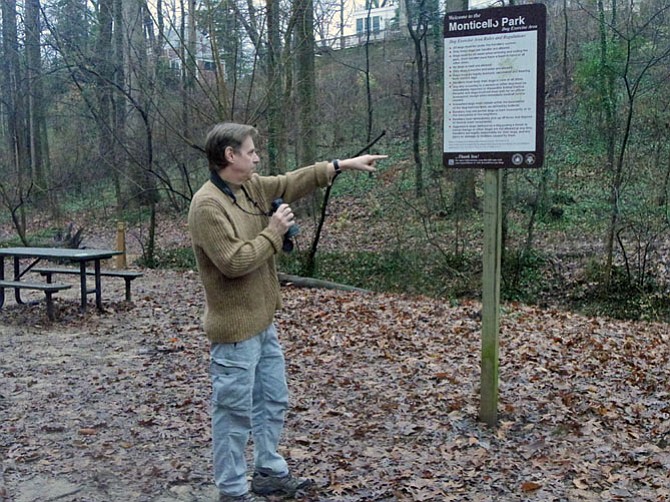“Over there,” Tom Albright points to the Winter Wren in the undergrowth at Monticello Park. He is participating in the 116th annual Audubon Christmas Bird Count that runs from Dec. 14-Jan. 5 each year. Photo by Shirley Ruhe/Gazette Packet
It was Saturday, Dec. 19 at Monticello Park on Beverly Street. Tom Albright has just joined the team recording the birds in part of Subsector 4 for the Christmas Bird Count. The Audubon Christmas Bird Count is held nationwide each year from Dec. 14-Jan. 5. It serves as an early census on the winter birds. Albright has been participating in this annual event at Monticello since 2004.
Albright walks past the large Monticello sign and starts into the park. He stops and looks up toward the ridge. "There's a flock of birds up there, high in the trees; there are robins and House Finches. I think it will be a good count day." He and two others start around the loop that parallels a small stream running through the park. "Listen," he says, "there is a chickadee," and his eyes search through the lower branches looking for the tiny black-capped bird. And Albright's eyes light up as he points to the far undergrowth on the right of the path. "There's a Winter Wren in there, a fairly unusual sighting."
The group will spend 45 minutes at this location and then move on to another part of the subsector of Sector 4 that includes Chinquapin, Cameron Run/Lake Cook, Ben Brenman and Fort Ward. This is the 116th annual Audubon Christmas Bird Count.
There is a specific methodology with each count taking place in an assigned 15-mile wide diameter circle. Volunteers follow a designated route counting every bird they see or hear that day. The team leader, in this case Paula Sullivan, keeps records of species, numbers and locations of birds and sends the numbers to a central location where thousands of reports across the United States and Canada are added to a historic database.
Albright moves past the large log that has fallen across the stream. Not much there today. In the background the hammering of a Downy Woodpecker punctuates the silence. At the end of the count they have totaled up 14 different species and 33 total birds. Except for 2013 that totaled only 9 species of birds, the last five years have all had 14 different species, although not always the same 14. Total number of birds has varied from the low of 11, also in 2013, to 70 in 2012, mostly due to 19 White- throated Sparrows, 9 Carolina Chickadees and 8 American Robins. Albright says, "The count depends on when you are there. You only get a feel for the birds in the area. An hour or two later you could see something else." Today Albright and the team spot a number of year round backyard birds including three Northern Cardinals, three American Robins and three Blue Jays. The rare Winter Wren is an exciting discovery.
In a way Monticello Park seems to be Albright's own personal place. The park is 4.5 acres of deciduous trees, fallen logs and undergrowth, good cover for spring and fall warblers. The small stream attracts warblers from high in the trees on a warm summer day — usually for the 10 a.m. bath. In early March Albright will begin his annual warbler watch, walking this same loop every day until May 31 and recording what he sees or hears. He has been keeping statistics on arrival and departure dates of species of warblers since 2005 and produces comparative bar charts over the years. He won't expect to see many warblers for weeks but "just in case." One year he recorded a surprise Pine Warbler on March 9. In late April the tempo of warblers picks up and “you can expect to see more than one species of warbler a day.” As the days go by, more warblers arrive for an average of 15-18 different species of warblers a day. By mid-May on a good day, Albright says “you can see 20 plus different species of warblers.” Each day Albright scratches the sightings in his notebook and sends out an email report to his ever growing list of interested birders. By summer warblers have migrated through the park but on July 25 and until mid-November Albright records the fall migration, generally slower and with birds in a different fall plumage.
Winter is just an interlude between migrating warblers for Albright. Only 60 days until the 2016 warbler count begins.


